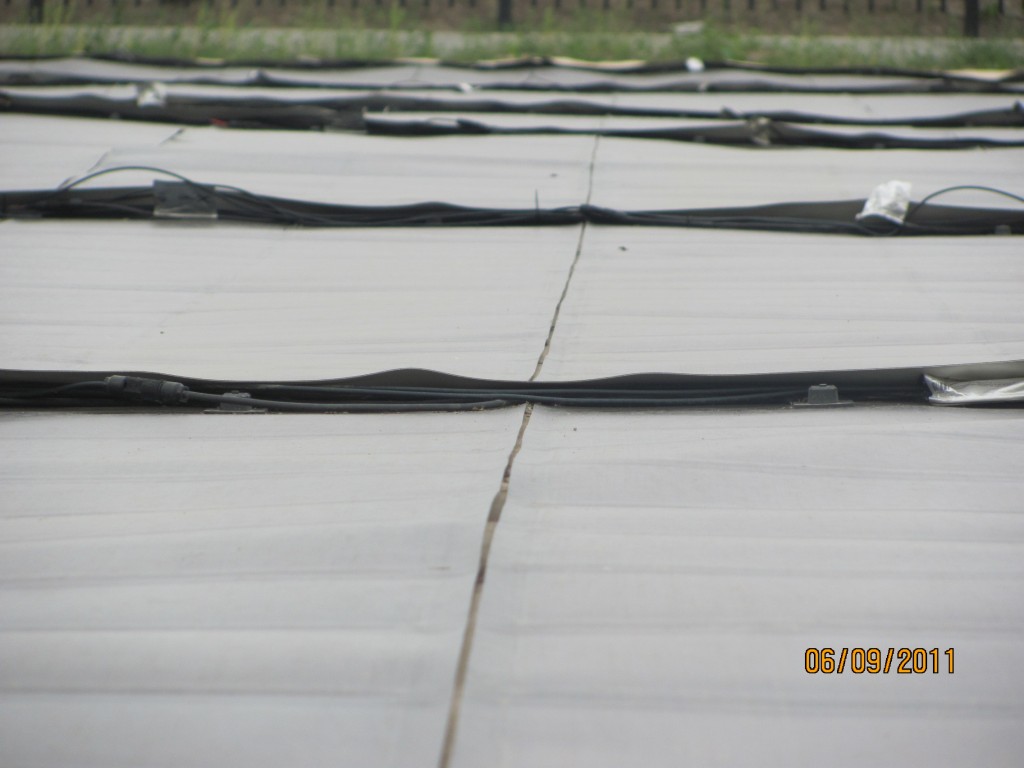Archive for the ‘Energy’
Solar Technology Shatters the Old Glass City
By: Nikia Washington
Toledo, long known as Glass City, earns the title of Solar Valley. The concept of renewable energy is spreading fast, as Toledo offers a home to new solar companies, ideas and efforts.
Death of Glass City
Toledo, a recognized portion of the Rust Belt and a key player in the auto industry, experienced a quick downward spiral at the turn of the century. Toledo’s unemployment rate has more than doubled in the last decade, reaching an 11.3 percent average in 2010. In the past 10 years, the nation’s unemployment rate increased by more than four percent, according to the United State Department of Labor.
Bill Stewart, special assistant to the mayor of Toledo, Michael P. Bell, explained Toledo took an economic dive due to its close ties with Detroit and auto production.
“Anything that happens bad to the autos, happens bad to Toledo,” Stewart said.
As reported by the Toledo Blade, the city lost more than 9,500 jobs between 2001 and 2004.
However, for the first time in years, Toledo’s economy recently showed an upward trend. President Obama visited the city’s Jeep plant in June of 2011 and announced an unemployment rate of 9.1 percent. The solar industry’s contribution to Toledo’s job market is a possible factor in the improvement.
What is Solar Energy
Solar power, as defined by the United States Environmental Protection Agency, is the energy received from the sun to create renewable energy.
Two types of solar technologies currently exist in the market: photovoltaic, which collects energy from the sun to provide electricity, and concentrated solar energy (solar thermal), which magnifies the intensity of the sun to create heat.
The solar thermal method uses the sun to warm an anti-freeze liquid in tubes called solar thermal collectors. The liquid is then transferred to a heating tank, commonly used for hot water and space heating. The photovoltaic method uses photovoltaic silicon cells, usually linked together to generate maximum power, to collect energy from the sun. A grid gathers the energy from the cells and then converts it to operational electricity.
Welcoming New Solar Companies
Late in the 1990s, a Toledo native gave birth to a company named First Solar. As reported by CNET News, Founder Harold McMaster previously worked with the glass industry during the 1940s and became an expert on tempered glass. In the 1980s, he experimented with the idea of solar energy and glass. In 1999, First Solar pioneered a goal to “provide an economically and environmentally viable alternative to peaking fossil-fuel electricity generation,” as presented on the company’s website.
First Solar provides solar services and products to businesses and organizations around the world, including China, Germany, and France.
The National Renewable Energy Laboratory (NREL), a research facet of the U.S. Department of Energy, regularly partners with First Solar.
“First Solar is one of the darlings of the solar world,” said Bill Scanlon, a public affairs representative for NREL.
First Solar now stands as one of the leading solar manufacturers in the world and one of the fastest growing, according to the company’s website. In addition to offices around the globe, one of the company’s three production facilities exists in the Toledo suburb of Perrysburg, the only First Solar production facility in North America.
In 2002, University of Toledo Professor Xunming Deng took a leave of absence to cofound solar manufacturer Midwest Optoelectronics, LLC. The company introduced a new form of lightweight, flexible photovoltaic solar technology.
The company was renamed Xunlight in 2006 and shipped its first solar modules in 2009. Xunlight is now Toledo’s second leading solar manufacturer.
Metropolitan Toledo is also home to numerous other solar manufacturers, including Isofoton and WK Solar Group LLC.
Waterways, shipping lanes, railroad capacity, trucking access and the strong history with the glass industry make Toledo a strong prospect to solar companies.
“We’re not a huge city like Chicago, New York, or Los Angeles,” Stewart said. “But we’re a big enough city that has all the amenities.”
Toledo’s Solar Venues
With a growing amount of local solar manufacturing, Toledo venues are taking advantage of the available solar technology. Richard Martinko, director of transportation research at the University of Toledo, is an active participant in processing of local solar projects.
“We have plenty of different locations where we have implemented solar power to help with efficiency,” Martinko said.
Solar fields, which are large quantities of solar panels installed in one location, now exist at Toledo’s Scott Park, near UT’s campus, the Toledo Art Museum, and elsewhere.
Scott Park, located off Moran Avenue between Dorr and Nebraska, currently contains photovoltaic solar panels that were developed and managed by the university. Students at UT can use the park for research.
“Scott Park directly correlates with the university and our energy consumption goals,” Martinko said.
As reported by eneryboom.com, a website for green investors, the goal of the Scott Park solar initiative is to decrease campus energy consumption by at least 20 percent by 2014.
UT also plans to have students participate in this year’s Solar Decathlon, in which schools from around the country showcase their solar ventures. This year’s decathlon will be held in Washington D.C.’s Potomac Park.
The Toledo Art Museum is one of Toledo’s existing buildings with new green initiatives. In 2008, First Solar installed solar panels on the roof of the structure to provide energy to the building.
Martinko said the art museum solar field was one of the largest in the state of Ohio upon production.
The I-280 solar project, a field of panels to the west of the Glass City Veteran Skyway, provides energy to bridge. After receiving a grant from the state, the Department of Transportation and UT teamed up for the project. The $1.7 million project shows significant decreases in energy costs. Panels by Xunlight and First Solar complete this large solar plantation, which went into effect in July of 2010.
Rise of Solar Valley
Across the United States and around the globe, manufacturers are looking to make solar energy more efficient.
NREL is currently working on two major projects that use technology and research from the University of Toledo: a “solar optical furnace” and photovoltaic cells that process the suns energy at a faster rate, Scanlon said.
Through the rising anticipation of Toledo as a solar super power, Stewart is reluctant to say that the new technology can single-handedly revive the city.
“I can’t say the solar industry has been this huge boom that has turned everything around. That’s not true yet,” said Stewart.
However, Stewart does recognize the potential solar energy can make, not just in northwest Ohio, but everywhere.
“Solar energy will last forever,” Stewart said. “As long as we have the sun, it will last.”
Let It Shine
I-280 Solar Panels Produce More Energy as Sun Rays Strengthen
Summer sun is allowing the Ohio Department of Transportation to cut energy expenses. During the first week in June, the solar panels along Toledo’s Interstate 280 near the Maumee River have produced enough energy to save $95 per day in the average cost of energy. This output is over 100 times greater than the first day of production in January 2011.
The Ohio Department of Transportation is taking part in a new trend in solar energy production, using the energy to power highways across the nation. Creating solar energy involves using solar panels to capture energy from the sun and converting it into power, most commonly electricity.
This year, the I-280 panels, used to power the Veterans’ Glass City Skyway Bridge, became the first solar highway in Ohio. The Skyway Bridge, along with most highway systems, requires large amount of energy to function, an expensive cost for transportation departments to maintain. In 2009, the Oregon Department of Transportation announced the premiere of the first solar highway, a highway powered by solar energy, in the country.
This solar panel project began in 2005 when Ohio Congresswoman Marcy Kaptor obtained a grant for an ODOT project. During the production of the Veterans’ Bridge, Richard Martinko, who was then employed for ODOT and project manager of the bridge, and his crew brainstormed on how to efficiently power the bridge.
Mike Gramza, district planning and engineering administrator for ODOT, said methane gas had been one alternative considered for the project. Martinko said energy could also be obtained from wind power.
ODOT selected solar energy toward the completion of the bridge project.
After being employed by UT as the director of transportation research, Martinko was familiar with the project’s power saving initiative. University of Toledo proposed to do a research for ODOT which would involve solar energy.
So far this summer, the panels have produced more than the amount needed to power the bridge.
Martinko explained that ODOT uses a net metering system to capturw and expend the energy.
“The panels produce energy, which goes to the onsite meters, and ODOT receives credit,” Martinko explained. ODOT stores the credit, which is used to provide electricity to the bridge. Because the bridge is now supplying its own energy credit, there is no need to purchase energy from the local supplier.

Meters maintained by the Energy Research Initiative (ERI) to collect data. Photo by Nikia Washington
Gramza explained that ODOT has two meters, one in current use, which captures the energy output of the panels.
“The energy companies are trying to buy the energy we produce for a fraction of the price it’s worth,” Gramza said.
Energy companies commonly attempt this method; they obtain energy for a lower cost and sell to their customers at regular price. To prevent losing money by selling the energy at such a low cost, ODOT has decided to begin using its second meter. This second meter will allow the city to collect more credit and provide more electricity. Without the second meter, additional energy would be lost.
These credits can be stored and will be useful during the colder months when the sun is weaker.
“There’s always more solar energy in the summer than there is in the winter,” said Allen Bowen, project manager for Advance Distributed Generation (ADG), the solar heating company that installed the panels and will maintain them until March 2012.
UT selected the Maumee-based branch of ADG, along with local companies Xunlight and First Solar, for the project.
“The University of Toledo did the design, maintenance, and review,” Gramza said.
Students and staff are responsible for the research conducted on the bridge.
“With the panels and work we’ve done onsite, it rounds out to about $1.7 million,” Martinko said, in reference to the total cost of the project.
Xunlight & First Solar provided the solar panels, each with two different models. The First Solar model resembles most glass panels, multiple photovoltaic cells beneath a layer of thick glass. The Xunlight panels are flat, lightweight, and flexible, most commonly used for roofing.
“What we would be comparing is the energy output from both of the panels,” Martinko said. He and Gramza were sure to note they are not comparing the efficiency of the two; there is not a competition between the two products.
UT also contracted with Energy Research Initiative, a company that gathers data daily from the solar panels. This data is the leading source for Lucid Designs, a website production company selected by UT to design a web database.
“We want to educate the public on the green initiative,” Martinko said.
In addition to the website, ODOT and UT have installed kiosks at the Interstate 75 rest stop south of Bowling Green and on UTs campus.
If the project goes well, officials want to power rest stops, signs, and maintenance garages with solar energy.

Mike Gramza defined the Xunlight panels as plastic blankets. To efficiently use the panels, construction workers had to build hill in order for the panels to lie on a slope. Photo by Nikia Washington
Going green in the home
Going green in something that everyone wants to do, but often times it seems like it is easier said than done.
There are a few, simple things that can be done around any house that can save energy emissions and even lower energy bill costs.
This video shows the benefits and some simple ways to go green, and these easy, cheap tricks are something that can be done in any home.
Go Green in the Home from kayceelyn5 on Vimeo.
This video was first created for Dr. Kathy Bradshaw’s Advanced Broadcast News JOUR 4300 class.
Lights off at BGSU
The oldest buildings on campus, Moseley, University and Hanna halls, can be considered creepy in the day time, but imagine what they are like when all the lights are off at night. On the outside, the old brick is covered with long vines, which make their way down the sides of the buildings. As they walk through Moseley, the old floors creak with each step, while the theaters in Hanna and University become even eerier as the lights go out. In order to reduce the university’s energy costs, students brave their fears and venture through their hallways and classrooms.

Junior, Jennie Hartman, participates in Friday Night Lights for the first time. "I think it's a great organization, and I definitely want to do it again," she said. Photo by Hannah Mingus.
Every Friday night, students at Bowling Green State University participate in Friday Night Lights, an effort to turn out lights in academic buildings on Friday nights. The program aims to help the university save money and become a “greener” campus.
At 6:30 p.m. each Friday, between 10 and 30 students meet outside of the Bowen Thompson Student Union Theatre. Students then divide and conquer – they split up into small groups and are given a clipboard with their assigned building on it. The clipboard gives them a list of rooms/ hallways on each floor, and how many light banks they can shut off for the weekend. After all the lights have been shut off, the students meet back in Olscamp to turn in their clipboards. The process usually takes less than an hour to complete.
Nick Hennessy, BGSU’s sustainability coordinator, has worked with the project since it was first launched in October 2009 by a former student, Dustin Sabo. Sabo first came up with the idea after learning of a similar program called Friday Night Lights Off at Penn State. He contacted Hennessy to help him figure out which buildings it would be beneficial to turn lights off in, figure out how to save money and keep track of it each week, and most importantly, how to get volunteers to help out with the program.
“It had good timing because it takes place before students’ Friday night plans,” Hennessy said. “Students want to help out, and it’s convenient community service and a fun event.”
Sabo gathered volunteers from his major, middle-childhood education, which is where he got his “core” group. Hennessy put information about it on an email list for environmental majors, and on the campus update. They relied a lot on word of mouth from students.
Sophomore Kaitlyn Bailey has been working with the program since nearly the beginning.
“It makes a huge impact with such little effort, and makes you feel really good that just by giving like 30 minutes of your time, you are making such a change every single week,” she said. “It’s also fun because you get to do it with friends and we always leave with inside jokes that will never get old.”
Bailey said one of her favorite memories of the group was when she and a few other volunteers discovered a box of free board games in East Hall, as well as a time when they accidentally turned the lights out on someone in the bathroom.
There was no opposition to the program when it started, but students did come across one problem.
“They unplugged the TV’s in the Business Administration, since no one looks at them,” Hennessy said. “They got flack for that since staff said they needed them on all weekend for weekend events.”
In fall of 2010, Friday Night Lights saved the University $13,260, according to Hennessy. Students turned off lights every Friday of the semester up to Dec. 10, not including the Friday after Thanksgiving. The best savings last semester occurred one week in September with $1,012, while the lowest occurred in November with $826. The average savings is usually between $800 and $950 per week, according to Hennessy. By not having lights on all weekend when no one is in the buildings, the university’s electric bill becomes substantially lower.

Various light switches across campus are labeled with the "Power Down BGSU" sticker to help remind students and faculty to switch off lights when not in use. Photo by Hannah Mingus
The program saves the most money by turning off lights in Education, Olscamp, Math Science, B.A. and Life Science buildings. Not because they are the “biggest energy hogs,” but because those buildings have much more going on, so there are more lights to turn off, according to Hennessy.
The only buildings on campus the volunteers do not go are the dorms, the Administration Building, and student affairs buildings such as Bowen Thompson Student Union, the rec center, field house and Jerome Library. Many of these buildings have their own process for turning off the lights, or they don’t have enough hallway light switches available.
BGSU is currently working on a project called Energy Control Management, which may put the Friday Night Lights staff out of a job in the near future. The project will have two phases. Phase 1 has already started, and it will involve replacing the heat/ ventilation, ducts and valves in buildings and having set point temperatures with digital controls. Phase 2 will deal with lighting and put motion sensor lighting in the buildings.
“It will be like Friday Night Lights every night of the week and day,” he said.



